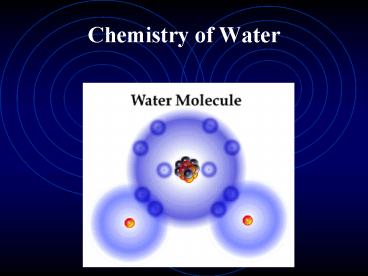Chemistry of Water - PowerPoint PPT Presentation
1 / 9
Title:
Chemistry of Water
Description:
H bonds form between water molecules and other charged substances ... Refractometer- measures the degree the light is bent (refraction) V. Chemical equilibrium ... – PowerPoint PPT presentation
Number of Views:301
Avg rating:3.0/5.0
Title: Chemistry of Water
1
Chemistry of Water
2
I. Water
- H20 is a compound of 2 hydrogen atoms and one
oxygen atom in a fixed proportion. - H20 is held together by covalent bonds (sharing
of e-) - H20 is bent into a 105 angle
- Water is electrically unbalanced because of the
angle and thus considered polar because of the
() and (-) end - H bonds form between water molecules and other
charged substances due to the polarity. This
allows water to itself, a process known as
cohesion - Adhesion is when water H bonds to other materials
- Water is a powerful solvent it will dissolve
almost anything
3
II. Seawater
- A. NaCl (salt) dissolves in water because of
its polarity (Na Cl-) - B. 97.2 of Earths surface water is marine
- C. Seawater is 96.5 water and 3.5 dissolved
substances (mostly salts) - D. Earth has 5.5 trillion tons of salt
- E. Salinity is the total quantity of dissolved
inorganic solids in water (NOT just salt!) - F. Salinty is usually 3.3-3.7 depending on
evaporation, precipitation, and fw runoff - H. Nearly every element found in the crust and
atmosphere is also present in the ocean - I. Major constituents of seawater include H, O,
Cl, Na, Mg, Ca, K, Sulfate, and bicarbonate - J. Elements lt1 ppm are called trace elements
4
III. Sources of ocean salts
- Weathering- running water dissolves crustal rock
- Excess volatiles- hydrothermal vents (underwater
volcanoes) on the ocean floor leak chemicals
(C02,Cl, S, H, F, N) into the water
5
IV. Determining salinity
- Proportion of Cl to salinity is constant
- Salinity in 1.81 x Cl
- Equipment
- Nansen bottle- bottle is sent down upside down on
a string, flipped open at a desired depth, and a
sample of water is taken - Salinometer- electronic electricity conductor
- Refractometer- measures the degree the light is
bent (refraction)
6
V. Chemical equilibrium
- The ocean is in chemical equilibrium
- For the most part, ions are added to the ocean at
the same rate they are subtracted - Certain ions have longer residency times then
others - Addition of salts from the mantle and weathering
are balanced by the subtraction of minerals bound
into sediments
7
VI. Colligative properties of seawater
- The heat capacity of seawater decreases with
increasing salinity (saltwater is less able to
hang on to heat) - As salinity increases, freezing point decreases
giving seawater a natural antifreeze property
(saltwater freezes at a lower temp than fw) - Salt water evaporates more slowly than fw (salt
hangs onto water) - The osmotic pressure of organisms increases with
increasing salinity (organisms lose more water
when salinity is higher)
8
VI. Dissolved gases
- Gases dissolve most readily in cold seawater
- Plants and animals in the ocean require dissolved
gases in order to survive - A. Nitrogen
- 48 of gas in ocean (atmosphere 78)
- living organisms require N to build proteins, but
bottom dwelling bacteria must fix the N into a
useable form for them - B. Oxygen
- 36 of gas in ocean (atmosphere has 100x more)
- Primary source of O in ocean is from plants
- most of the oxygen is near the surface and
diffuses into the atmosphere - Carbon dioxide
- 15 of gas in ocean (60x more in ocean than
atmosphere) - used by marine plants- low at surface
9
VII. pH
- Acidity (release of H) and alkalinity (release
of OH-) is measured by pH - pH scale 0-------------------7----------------
--14 - acid neutral base
- Pure water is neutral (7)
- Seawater is slightly alkaline (avg. 7.8)
- The ocean contains buffers to prevent large
swings in pH when acids or bases are introduced































